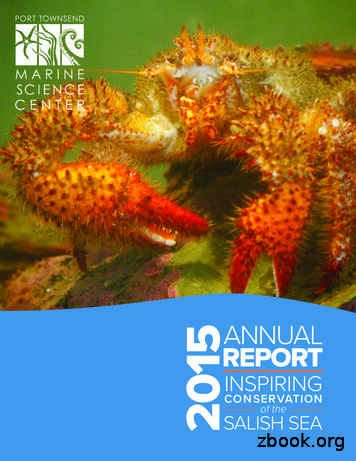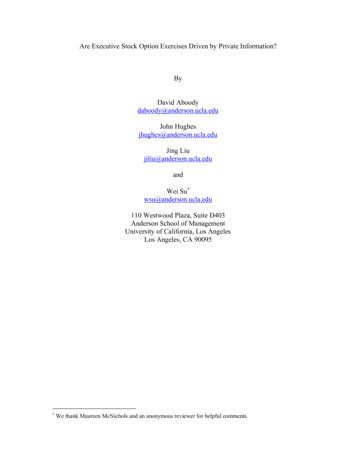Presented By Lindsey Anderson
Interagency CollaborationPresented by Lindsey AndersonOSSE Division of Specialized EducationSecondary Transition Webinar Series
Objectives1. Define interagency collaboration2. Describe the purposes of interagency collaboration3. Identify potential barriers and ideas for eliminatingthem4. Identify characteristics of effective collaboration5. Identify how interagency collaboration functions atnational, state, and local (including school) levels
Guiding Questions1. What is interagency collaboration (and how will weknow it if we see it)?2. What are our purposes for collaboration?3. How will we see and eliminate barriers?4. What are characteristics of effective collaborationfor improved transition outcomes?5. How do interagency teams function at the state,local, and school levels? How do we build them?
Guiding Question 1What is interagency collaboration(and how will we know it if we see it)?
No Consensus for a DefinitionSpecialEducationCareer & TechEducationCommunityRehab.ProvidersPhysicians &SpecialistsParentInfo. & TrainingCentersPsychologistIndependentLiving sumerOrganizationsYouth &FamilyOne StopsIDMHNo commonlyused definitionof interagencycollaborationfound acrossmultipleresearchstudiesbetween 1982and 2009Support GroupsVoc. Evaluators &Work ralEducationVocationalRehabilitationKester, J. (2012); Test,Mazzotti, Fowler,Kortering, &Kohler.(2009)
How will we know it when we see it?What does collaboration mean, basedupon the ecology and environment oftransitioning youth?This leads us to explore the definition ofinteragency collaboration
Defining Interagency Collaboration“Collaboration is generally defined as aprocess of participation through whichpeople, groups, and organizations formrelationships and work together toachieve a set of agreed-upon results.”Kochhar-Bryant, 2008, p. 7
Defining Interagency Collaboration Interagency collaboration involves relationshipsamong people in different roles and disciplinesin schools, among schools, with human serviceagencies, and in communities. Collaboration is the “people part,” which goeshand in hand with the organizational level ofsystem coordination.Kochhar-Bryant, 2008
Defining Collaboration Collaboration: process ofdiscovery whererelationships and newknowledge are constructedthrough a synthesis of ideas These are outcomes of sociallearning that are built uponthe trust and cooperation ofthe group of collaborators(Kochhar-Bryant, 2008)
Definition of CollaborationProcesses, activities and relationships of agroup that results in the exchange ofinformation, sharing, and pooling of resourcesfor mutual benefit to achieve a commonpurpose.
Guiding Question 2What are our purposes forcollaboration?
Failing at Interagency CollaborationDespite legislation andmultiple agencymandates, we continue tohave systemsfragmentationNational Council on Disability (2008)
Lower Post-School OutcomesGeneralPopulation ofYouthYouth withDisabilities(NLTS-2, 2010;Test, Aspel & Everson, 2006)
Purposes for Engaging in Interagency Collaboration1. To improve the academic, postsecondary, and lifelong success of students.2. To try new ways of working together to accomplish#1.3. To be rejuvenated and use our creativity toaccomplish #1.4. To expand the number of people who can help usaccomplish #1.5. To eliminate our feelings of being a lone advocate.
Guiding Question 3What are challenges or barriers toeffective collaboration forimproved transition outcomes?
Review of Challenges or BarriersOrganizational or SystemBarriers No cooperative processes oragreements Incongruent policies Separate funding streamswith different purposes Changes in priorities &legislative shifts Inadequate data collection &reportingAttitudinal Barriers Political pressures Territorialism Staff turnoverKnowledge Barriers Lack of understanding of owndisciplines, agencies, etc. No knowledge of new modelsfor collaboration
Ecological or Environmental Factors Complexity oftransition system ofagencies Agency culturaldifferences Different languages Change processes Legal mandates
The Collaboration PuzzleAgency MissionFunding and resourcesAccountabilityProfessionals’ jobdescriptions and roles Linkages and formalagreements Already formedrelationships
What Happens to Supports for Employment of YouthAfter High School?Let’s take a look at aGovernment AccountabilityOffice (GAO) report entitledBetter Federal CoordinationCould Lessen Challenges inthe Transition from HighSchool GAO-12-594, Jul 12,2012.Available athttp://www.gao.gov/products/GAO12-594
Supports After High School?Challenges in accessing federally funded programs: Difficulty navigating multiple programs that arenot always coordinated; Possible delays in service as they wait to beserved by adult programs; Limited access to transition services; A lack of adequate information or awareness ofavailable programs that may provide transitionservices after high school; Lack of preparedness for postsecondaryeducation or employment.
Key Federal Legislation Providing Servicesto Transitioning Youth21
Obtaining Services after High SchoolAcross MultiplePrograms22
Potential Partnerships: Transition Collaboration Student and their families School personnel––––––AdministratorsSpecial Education TeachersGeneral Education TeachersCareer & Tech. EducatorsCounselorsRelated Services Post-secondary education &training– Trade & technical schools– Community college– Universities Adult Government Services– RSA– DDA– Mental Health Community Servicesproviders––––ARCGoodwillAdvocacy GroupsAttorney Advocates Businesses (includingChamber of Commerce) Other community partners
Call for Enhanced Coordination and Collaboration To improve supports for transitioningyouth, the report calls for improvedcoordination not only at the federallevel, but at the state, regional, andlocal levels, including schools!This leads us to Guiding Question 4
Guiding Question 4What are the characteristics ofeffective collaboration forimproved transition outcomes?
Models of Effective Interagency CollaborationCIRCLESCommunitiesof Practice
Renewed Optimism for Effective Collaboration Researchers are showing renewed interest (e.g., Kester,Noonan, Wenger) Outcomes of research targeting collaboration for transitioningyouth:– Communities of Practice (often called Transition Councilsat School Levels)– Circles (being piloted by OSSE in the District) Collaboration does not happen in a vacuum – we need tocreate a context and deliberate opportunities to developcollaboration to benefit transitioning students
Optimism for Improving CollaborationCommunities of Practice (CoP) CoPs are being implemented at local, district,state and national levels around theissue/topic and problems of transition forstudents with disabilities. OSSE and School Talk facilitate the District’sCoP on Transition
Optimism for Improving CollaborationThere is hope that the challenges of interagencycollaboration in secondary transition can be overcome,as reflected by one interviewee in Kester’s research:“It’s very seldom that you have a group of individuals fromso many different backgrounds and perspectives, and yetin my time there I haven’t seen individual agendas. I’veseen the main agenda of how are we going to help thesestudents be successful.” (Participant 18, interview, January30, 2012)29
Communities of Practice Communities of Practice are“vehicles” for social learning(Wenger, 1998) They are defined as groupsof people who shareexpertise and passion abouta topic and interact on anongoing basis to furthertheir learning in theirdomain (Wenger, 2002)
A Context to Grow Transition PracticesNo one agency can do it alone it takes acommunity!Communities of practice create an environment wherethere are strengths in numbers and practices can bedeveloped and implemented through shared work.31
Formation of a CoP Share a commondomain of interest Develop a community Share practice andresources32
What do Communities of Practice Look Like?Problem SolvingSharing InformationCoordination &SynergySharing rces& Identifying Gaps33
DC Secondary Transition Community of Practice HighlightsNot “owned” by any one organization:– Agenda set by the group,– Based upon needs of students,– Members take on various leadership roles;– Meets once a month in person (may havesmaller meetings virtually or telephonically)– Some who attended with reluctance arenow energized and actively participating– The process is working34
DC Secondary Transition Community of Practice Highlights Subcommittees change each year with new priorities(youth engagement, family engagement, etc.) Recent Outcomes:– White Paper on Self Determination—led to Student-led IEPinitiative– Transition Process Toolkit– Transition Assessment toolkit– Secondary Transition Website– State Capacity Building Institute– Annual Moving Forward with Transition Forum (SchoolTalk)– CIRCLES
DC Secondary Transition Community of Practice ocatesPostsecondaryEducationInstitutions
Guiding Question 5How do interagency teams function atthe state, local, and school levels andhow do we build them?
Common Themes of Successful Collaboration1. Forming new relationships with people2. Sharing human and other resources3. Building trust among people working asequals (non-hierarchical) relationships4. Requiring joint responsibilities for outcomes5. Involving joint decision-making and actions6. Aiming for specific, agreed upon results andchangeKochhar-Bryant & Heishman, 2010
Levels of Collaborative Teams National Level– National Transition Community of Practice (sponsored bythe IDEA Partnership, www.sharedwork.org) DC level– DC Transition Community of Practice Need to develop collaborative teams at the schoollevel– Transition Councils or CoPs IEP TeamsLet’s take a look at the CIRCLES model of collaboration 39
Rejuvenating and Energizing We change the way we work We continue to work positivepostsecondary outcomes for ourstudents We become re-energized andenthusiastic We are not alone!
Interagency Transition TeamsWho - Comprised ofrepresentatives of keystakeholders (includingthe decision makers)How – Workstrategically to developand implement policyWhat – Improveadult life outcomes
CIRCLES: Multi-Level Approach to Transition Planningfor Students with DisabilitiesCommunityLevel TeamStudentLevelTeamSchoolLevelTeam
Community-Level Team Discuss policy Collaborate for servicedelivery Do NOT work directlywith students Meet 2-4 times/year MOST IMPORTANTLY ExecutiveLevel Leaders
Appoint a Representative to Serve on School-Level TeamAppointed RepresentativeCommunityLevel TeamSchoolLevel Team
School-Level TeamDirect ServiceProviders &SchoolPersonnel Work DIRECTLY withstudents/families Collaborate to provideservices to INDIVIDUALstudents See students from multipleschools for transitionplanning Meet monthly AND
Submit Pre-planned Transition Goals to IEP TeamSchoolLevelTeamTransition GoalsIEP Team
Student- Level (IEP) TeamSchool andStudentSpecific TeamMembers Prepare students to presentat the School-Level Teammeeting Bring pre-planning fromSchool-Level Team back tothe IEP meeting to Write transition plan
Interagency Collaboration Improved Post School OutcomesCommunityLevel TeamSchoolLevelTeamIEP TeamImprovedPost-SchoolOutcomes forStudents withDisabilities
CIRCLES in DC Highlights Opportunity to develop opportunities forincreased self-determination and interagencycollaboration During it’s first year:– 4 schools participated– 20 students were served49
“We build the road and the road builds us.”
Wrap UpGuiding Questions:1. What is interagency collaboration (how willwe know it if we see it)?2. What are our purposes for collaboration?3. What are characteristics of effectivecollaboration for improved transitionoutcomes?4. How will we see and eliminate barriers?5. How do interagency teams function at thestate, local, and school levels?
ReferencesKester, J.E. (2013). Exploring interagency collaboration in a secondarytransition community of practice. Unpublished Doctoral Dissertation.Washington, DC: The George Washington University.Kochhar-Bryant, C.A. (2008). Collaboration and system coordination forstudents with special needs. NJ: Saddle River. Pearson,Merrill/Prentice-Hall.Kochhar-Bryant, C.A., & Heishman, A. (2011). Effective collaborationfor educating the whole child. CA: Thousand Oaks: Corwin Press andNational Staff Development Council.Miller, R. & Corbey, S. (2010). Chapter 7: Transition planning andinteragency cooperation. In L. West (Ed.). Integrating transitionplanning into the IEP process (pp. 69-78). Arlington, VA: Councilfor Exceptional Children.
ReferencesNoonan, P.M., Morningstar, M.E., Erickson,M. & Gaumer A. (2008).Improving interagency collaboration: Effective Strategies used byhigh-performing local districts and communities. Career Developmentfor Exceptional Individuals 31, 132-143.Stodden, R. A., Brown, S. E., Galloway, L. M., Mrazek, S., & Noy, L.(2004). Essential tools: Interagency transition team development andfacilitation. Minneapolis, MN: University of Minnesota, Institute onCommunity Integration, National Center on Secondary Educationand tialtools/teams/background.aspTest, D. W., Mazzotti, V. L., Mustian, A. L., Fowler, C. H., Kortering, L., &Kohler, P. (2009). Evidence-based secondary transition predictors forimproving postschool outcomes for students with disabilities. CareerDevelopment for Exceptional Individuals, 32(3), 160-181.
“It’s very seldom that you have a group of individuals from so many different backgrounds and perspectives, an
Anderson Ben Anderson C. [Clarence] W. [William] 1891 1971 Anderson David Kimball 1946 Anderson Don [Donald] 1919 Anderson Frank Hartley 1890 1947 Anderson Frederic A. 1894 1950 Anderson H. Christian Anderson Herbert S. 1893 1960 Anderson James P. 1929 Anderson Jeremy 1921 1982 Anderson Karl 1874 1956 Anderson Laurie 1947 Anderson Lee B .
American Bank of the North American Legion McVeigh Dunn Post 60 American Legion Post 122 Analytical Technology, Inc Erik & Christina Andersen Anderson Family Dental Bruce & Linda Anderson Charles & Donna Anderson Douglass R Anderson & Jean M Schaeppi-Anderson Elizabeth J Anderson Gary W Anderson Jerry & Cathie Anderson Rick & Patti Anderson .
Alatalo, Alex 233 Allen, Kustaa 232 Allman, James 157 Alston, Joe 102 Anderson, John E. 402 Anderson, John Eric 124 Anderson, Kusti 143 Anderson, Lars 34 Anderson, Louis 241 Anderson, Matti 106, 141 Anderson, Nikolai 132 Anderson-the-Finn, Maunu 34 Anias, Heikki
229 SLEIGH RIDE ANDERSON, LEROY 23 302 SANDPAPER BALLET ANDERSON, LEROY 30 754 TYPEWRITER, THE ANDERSON, LEROY 76 755 BLUE TANGO ANDERSON, LEROY 76 793 CHRISTMAS FESTIVAL, A ANDERSON, LEROY 81 1821 Clarinet Candy Anderson, Leroy 202 1943 The Phantom Regiment Anderson, Leroy 215 86 BUGLER'S HOLIDAY ANDERSON,
Lindsey Wilson College Program of Nursing BSN Student Handbook Bob & Carol Goodin Nursing & Counseling Center 210 Lindsey Wilson Street Columbia, KY 42728 Office: 270-384-7352 Email: nursing@lindsey.edu FAX: 270-384-7353 Office 117 LWC Main Number: (270) 384-2126 or (800) 264-0138
CyberGrants Inc. Dell Technologies Deneen Pottery Enrico Arts Four Seasons Resort GE Foundation Global Impact . Patricia & Morgan Anderson Ryan Anderson Sandy Anderson Sean Anderson Steve Anderson Stewart Anderson Tom Anderson . Stanley Barnes Cindy Barnett Gabe Barnett Jo
Alcaraz · Kevin Alexander · Catherine & Tom Anderson · James Anderson · Janine Anderson & Terry Lievre · Paul & Joyce Anderson · Normandie & John D. Anderson · Ross Anderson & Mary Rothschild · Susan Marie Andersson · Phil Andrus & Emmy Lou Stein · Tom Armitage & Meg Parisi ·
Are Executive Stock Option Exercises Driven by Private Information? By David Aboody daboody@anderson.ucla.edu John Hughes jhughes@anderson.ucla.edu Jing Liu jiliu@anderson.ucla.edu and Wei Su wsu@anderson.ucla.edu 110 Westwood Plaza, Suite D403 Anderson School of Management University of California, Los Angeles Los Angeles, CA 90095























